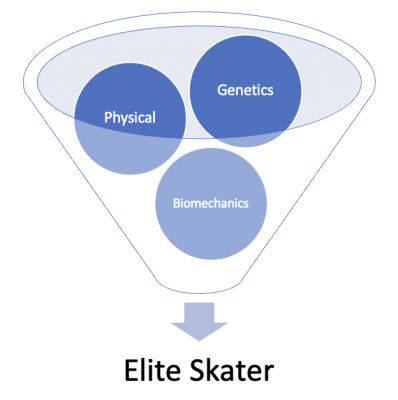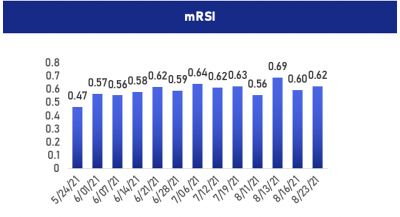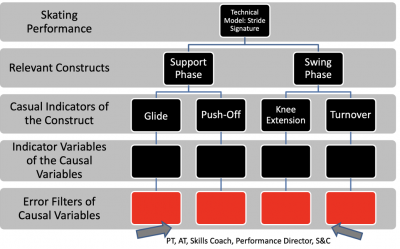What makes a great skater? This is a complex question to answer. The truth is, no two strides are the same and there is no perfect answer. Skating, like playing the guitar, is a skill. There are plenty of players playing at high levels that have unorthodox stride signatures. The game of hockey is complex, and although skating comes at a premium, one also must consider hockey sense, technical, and tactical tendencies as all may lead to efficiency on the ice.
So, the question remains. What makes for a great skater? Below is what I call the skating funnel. It moves from foundational to specific. All components, I consider important for being an efficient skater on the ice. Let’s take a look at each component in more detail.

- Genetics: Thank Mom and Dad for this one. Although certain characteristics of muscle architecture can be trained, it’s also highly genetically dependent. In other words, everyone has a unique ceiling. In terms of muscles and human movement, two of the most important architectural parameters are physiological cross-sectional area (PCSA) and fiber length. Muscle force is proportional to PCSA, and muscle velocity is proportional to fiber length. Longer muscles generate higher velocity movement which may be critical for speed on the ice.
Lever length also plays a role. Work is equal to force applied over a distance. Thus, if we increase the length of a lever, we can reduce the force needed to get work done. This is the equivalent of riding a bike with a WD40 chain as opposed to riding a bike with a rusty bike chain. Efficiency is maximized with longer levers. You can’t train this!
- Physical/Trainable Qualities: These are what I consider trainable variables that are critical to be a fast, efficient skater.
- Mobility: Movement efficiency is the ability to effectively reach a desired posture or position. As we age, many times we lose the requisite mobility needed to attain these postures and in doing so tremendously compromise our conditioning on the ice. Impulse is a product of net force and the amount of time the force is applied. If we can produce force for longer periods of time, we can create more impulse. If a young skater can gain a few extra inches of knee bend, he/she can effectively increase the amount of time that force is applied and be much more efficient re: energy expenditure.
- Strength: In order to overcome inertia and accelerate, strength is needed to create pressure between the ice and the skate blade. Researchers have found significant differences between off-ice lower body strength tests and acceleration ability. Elite players could jump significantly further in the single leg broad jump than lower caliber players [1-3]. It appears that higher levels of strength may differentiate elite from non-elite skaters. Step width is the measurement from the ipsilateral foot relative to the contralateral foot during propulsion. Large amounts of hip abduction are needed in conjunction with large step widths to improve acceleratory ability on the ice [1,2,4]. In order to produce large step widths requisite strength is needed to produce friction in a non-friction environment.
- Rate of Force Development: Turnover, turnover, turnover! How fast can you apply force? Stride rate has been found to further separate acceleration ability between elite vs non-elite skaters. While skating at easy, moderate, and high velocities researchers have found a correlation between stride rate and both single and double leg support times. In other words, as speeds increase support times decrease and stride rates increase. This reinforces the concept that at higher speeds the number of times the force of propulsion is applied may be more important than the force at each propulsion [5,6]. Stride rates are typically much greater for higher caliber players [3,4,6,7].

One of the force plate variables we look at to measure rate of force development.
- Biomechanics: As Arnold Palmer famously quoted: “Swing your swing. Not some idea of a swing. Not a swing you saw on TV. Not that swing you wish you had. No, swing your swing. Capable of greatness. Prized only by you. Perfect in its imperfection. Swing your swing. I know I did.” Although no two swings are the same, its important to note if a swing falls outside an acceptable bandwidth in which slight adjustments may lead to massive improvements. This is much easier when working with a novice when compared to elite players. When it comes to biomechanics, there are four heuristics I look at re: the skating stride.
- Stride frequency increase with each step
- Glide time increases with each step (from run to glide)
- Trunk segmental angle remains low
- Placement of recovery leg below hip in preparation for proceeding push off
I then create a skating performance model and “plug and play” the variables that I think may reinforce improved mechanics on the ice. Obviously, the best way to do this is ON the ice which is why a great relationship with a skills coach is imperative.
To Do: Create a “Theoretical Skating Model” (Listed Below)
- Fill in the “Indicator Variables of the Causal Variables” for on-ice skating mechanics. What is an acceptable biomechanical bandwidth for each phase based on the 4 heuristics?
- Fill in the “Error Filters of Causal Variables” to indicate how you would aim to fix issues experienced on the ice. In other words, what baseline physical competencies and exercises serve to complement these phases within the stride. Can you train them?

Like many issues in team sport, there are no concrete answers, just conjecture rooted in experience and objective information. My current hypothesis is the skating funnel as these attributes, I feel lead to efficient skaters on the ice.
References:
Budarick, A.R.; Shell, J.R.; Robbins, S.M.; Wu, T.; Renaud, P.J.; Pearsall, D.J. Ice hockey skating sprints: run to glide mechanics of high calibre male and female athletes. Sports Biomech. 2018, 1-17.
Shell, J.R.; Robbins, S.M.; Dixon, P.C.; Renaud, P.J.; Turcotte, R.A.; Wu, T.; Pearsall, D.J. Skating start propulsion: three-dimensional kinematic analysis of elite male and female ice hockey players. Sports Biomech. 2017, 16, 313-324.
Upjohn, T.; Turcotte, R.; Pearsall, D.J.; Loh, J. Three-dimensional kinematics of the lower limbs during forward ice hockey skating. Sports Biomech. 2008, 7, 206-221.
McPherson, M.N.; Wrigley, A.; Montelpare, W.J. The biomechanical characteristics of development-age hockey players: Determining the effects of body size on the assessment of skating technique. In Safety in ice hockey: fourth volume, ASTM International: 2004.
Marino, G.W. KINEMATICS OF ICE SKATING AT DIFFERENT VELOCITIES. Res. Q. 1977, 48, 93-97, doi:10.1080/10671315.1977.10762155.
Wu, T.; Pearsall, D.J.; Russell, P.J.; Imanaka, Y. Kinematic comparisons between forward and backward skating in ice hockey. In Proceedings of ISBS-Conference Proceedings Archive.
Stidwill, T.; Pearsall, D.; Turcotte, R. Comparison of skating kinetics and kinematics on ice and on a synthetic surface. Sports Biomech. 2010, 9, 57-64.